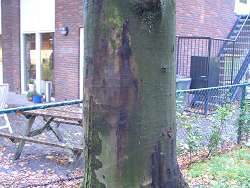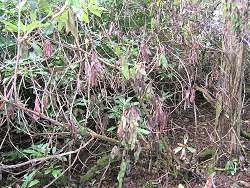Summary
Summary
 Phytophthora research is focussed on assessing the impact of various Phytophthora species, including newly emerging diseases caused by species such as P. ramorum, P. kernoviae, P. lateralis, and P. austrocedri. In addition, established Phytophthora species showing changed behaviour, perhaps due to climate change or exposure to new hosts, are also under investigation.
Phytophthora research is focussed on assessing the impact of various Phytophthora species, including newly emerging diseases caused by species such as P. ramorum, P. kernoviae, P. lateralis, and P. austrocedri. In addition, established Phytophthora species showing changed behaviour, perhaps due to climate change or exposure to new hosts, are also under investigation.
Phytophthora (Greek for ‘plant destroyer’) is one of the world’s most destructive genera of plant pathogens. Probably the most famous species of the genus in Phytophthora infestans, which attacks the leaves and stems of potato plants and causes the disease that contributed to the potato famine in Ireland in the mid 1800s. Since the early 1990s the profile of Phytophthoras in forests and natural ecosystems has risen markedly around the globe and diseases such as Phytophthora disease of alder and Sudden Oak Death are widespread and highly damaging in some countries.
Research objectives
- Effective diagnosis and detection of Phytophthora pathogens which affect trees.
- Understand the distribution and the impact of recently introduced Phytophthoras, such as Phytophthora ramorum, P. kernoviae and P. lateralis, to trees in Britain.
- Assess the susceptibility of forest and woodland tree species to P. ramorum and P. kernoviae to gauge the potential risk these pathogens pose to our trees and environment and inform future planting recommendations.
- Analyse the extent of variation in some of the recently arrived Phytophthora species to identify the possible origins, entry pathways and potential for genetic change.
- Obtain field data on the infection process and disease development in relation to key variables (e.g. host availability, inoculum production and climate).
- Determine how Phytophthora pathogens spread in natural and semi-natural environments.
- Through increased understanding of the biology of Phytophthora pathogens, provide effective advice to aid management decisions on management, containment and eradication.
Pest risk analysis (PRA)
The European PRA of P. ramorum is now available.
Funders and partners
![]()
![]()
![]()
![]()
This research is funded by the Forestry Commission as part of the Phytophthora Diseases Work Area and Defra. Current and past research support comes from various EU projects and COST Actions and the USDA Forest Service
Status
Work on Phytophthora diseases of trees has been a key part of the work of Forest Research for many years. Research on Phytophthora ramorum and P. kernoviae started in 2003 and was extended in 2011 to include other damaging Phytophthoras such as P. lateralis, P. austrocedri, P. pseudosyringae and P. cinnamomi as part of the Tree Health work in Delivering Resilient Forests and Understanding Biotic Threats.
